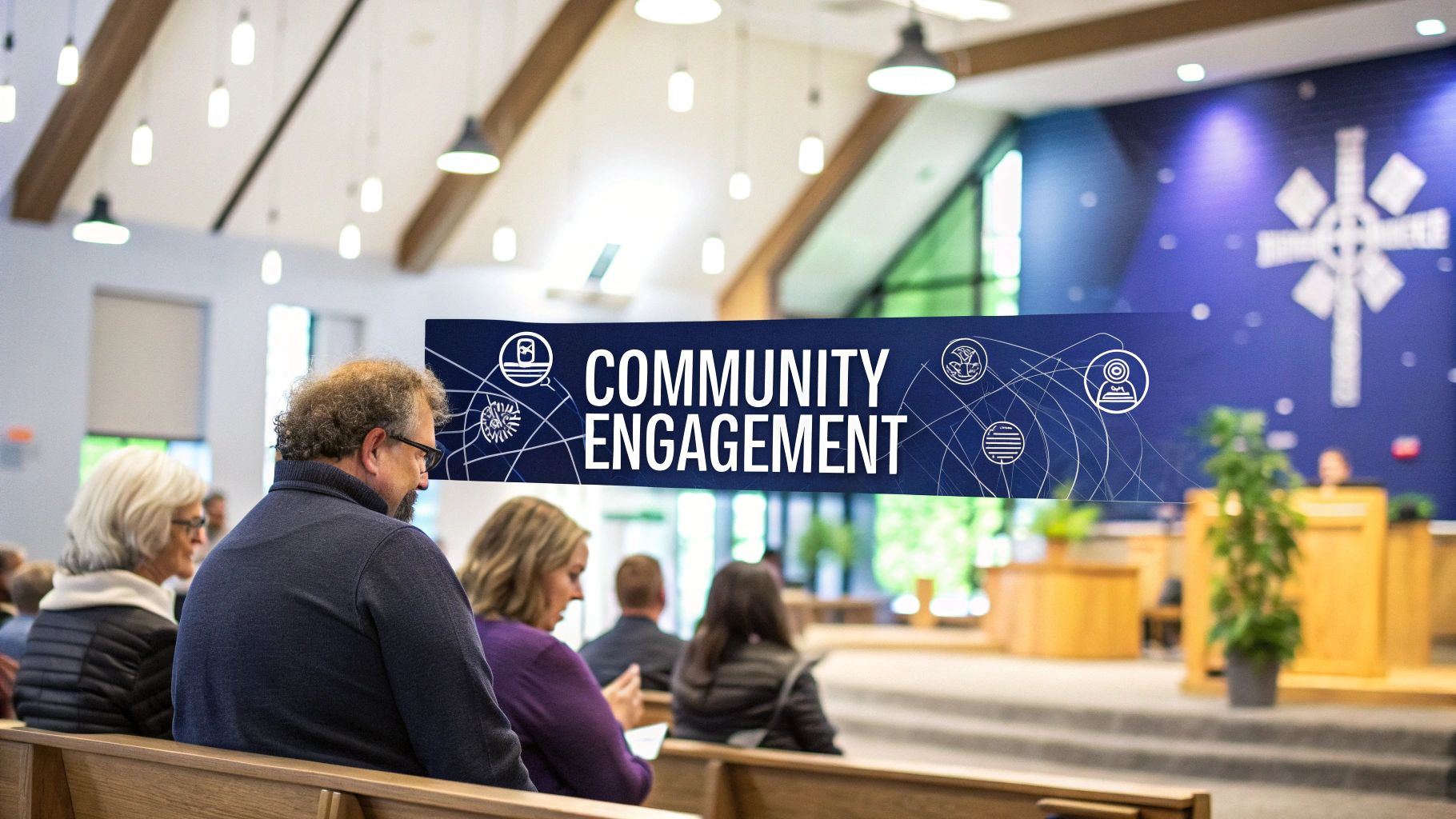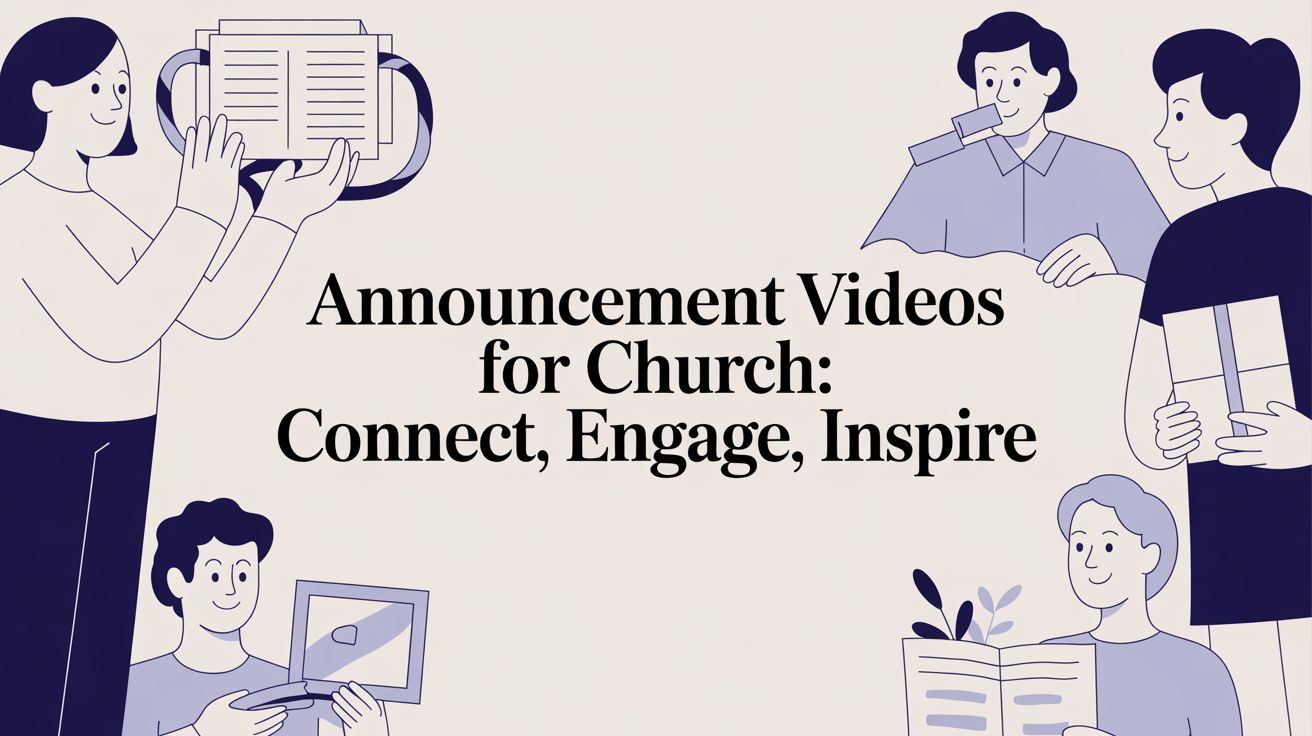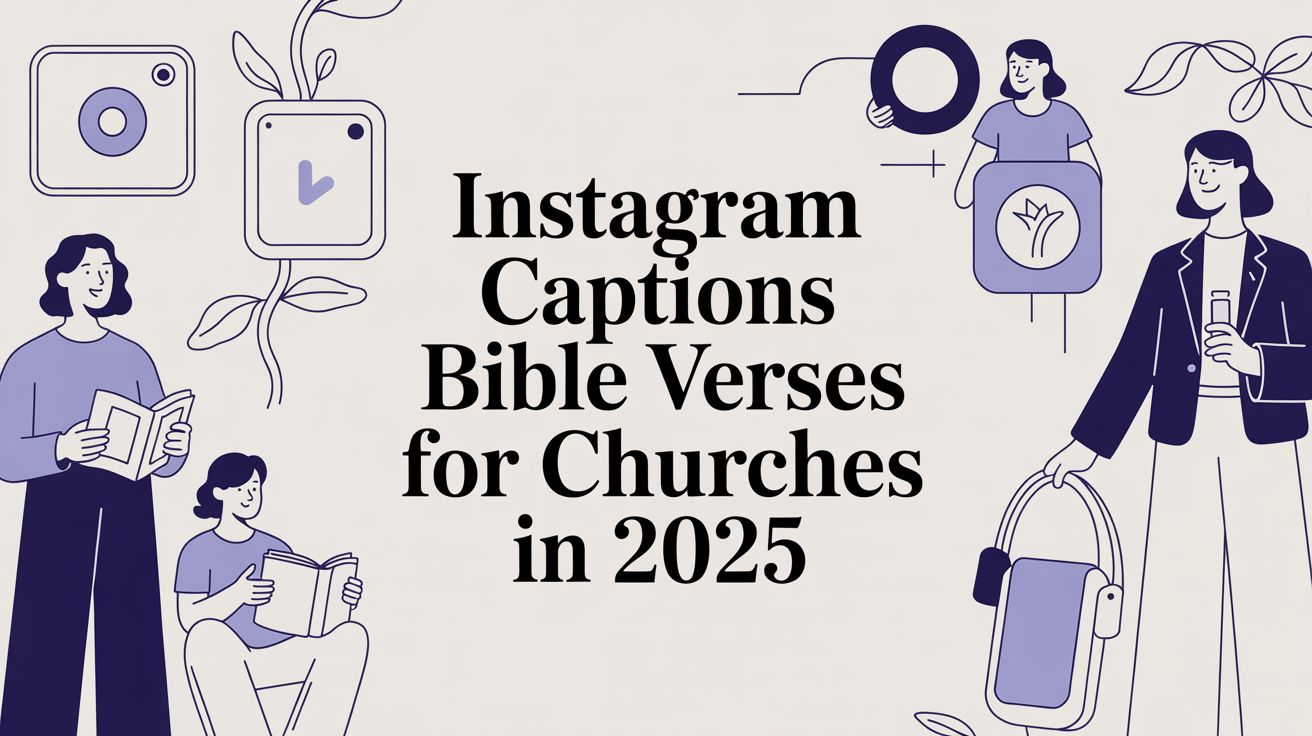A church's community extends far beyond its physical walls. Authentic connection now blossoms every day of the week through shared online moments, supportive conversations, and a consistent digital presence. Fostering this environment requires more than occasional posts; it demands a strategic approach grounded in proven community engagement best practices specifically adapted for the church's unique mission. Moving from a Sunday-centric model to a daily dialogue is essential for modern ministry growth.
This guide provides a clear roadmap. We will detail nine essential strategies designed to build a vibrant, engaged, and growing online community. You will discover actionable steps for creating meaningful two-way conversations, making your content more inclusive, and celebrating the contributions of your members. We'll explore practical tactics, from transforming sermon transcripts into shareable social media posts to establishing a culture of transparent communication.
Throughout this listicle, we will also demonstrate how integrating a tool like ChurchSocial.ai can streamline these efforts. From its AI-powered content creation tools that turn sermons into reels and posts, to its simple drag-and-drop calendar and graphic editor, you can efficiently plan and manage your church social media accounts. Let's dive into the practices that will help your church flourish online.
1. From Sermon to Social: Repurpose Your Core Message for Digital Outreach
Your weekly sermon is the cornerstone of your ministry's teaching, packed with powerful insights and inspiration. One of the most effective community engagement best practices is to extend the life of that sermon far beyond Sunday morning by transforming it into various digital formats.
This strategy creates multiple touchpoints for engagement throughout the week, reinforcing your message for members and reaching new audiences online. This isn't just about sharing a recording; it's about deconstructing the sermon into bite-sized, shareable content that meets people where they are: on their social media feeds.
Practical Implementation
Start by identifying the key themes, quotes, and calls to action from the sermon. Then, transform these core ideas into diverse content formats.
- Video Reels: Create short, impactful AI-generated reels (15-60 seconds) highlighting a powerful sermon point.
- Quote Graphics: Design visually appealing graphics featuring a memorable quote from the message using professional templates.
- Discussion Prompts: Pose a thought-provoking question related to the sermon's application to spark conversation in the comments.
- Blog Posts: Expand on a sermon sub-point with a detailed blog post, offering deeper context and practical steps.
Sustaining this digital dialogue is key. To support the creation and sustained growth of your digital community, refer to these expert tips on building a thriving online community.
Leveraging ChurchSocial.ai
This process can be streamlined significantly. With ChurchSocial.ai, you can upload your sermon transcript and let our AI generate ready-to-use social posts, discussion questions, AI-generated reels, and even blog content. Use our graphic templates and editor to quickly create and post photos and carouels, then schedule everything in our simple drag-and-drop calendar to easily manage and update all of your social media.
2. Inclusive and Accessible Engagement
True community engagement ensures every individual, regardless of ability, background, or technical skill, can fully participate. One of the most critical community engagement best practices is to intentionally remove barriers, creating a welcoming environment for all. This means moving beyond a one-size-fits-all approach and actively considering the diverse needs within your congregation and local community.
This practice involves offering multiple formats for engagement, accommodating different needs, and actively reaching out to groups who might otherwise feel marginalized. It’s about ensuring that every voice has the opportunity to be heard and valued, reflecting the all-embracing nature of the Gospel.

Practical Implementation
Begin by auditing your current engagement channels, from your physical building to your digital platforms. Think about who might be unintentionally excluded and what steps can be taken to invite them in. This proactive approach builds trust and demonstrates a genuine commitment to inclusivity.
- Offer Multiple Formats: Provide various ways for people to connect, such as in-person gatherings, live-streamed services with chat features, and phone-in options for those without internet access.
- Use Clear Language: Write all communications, from website copy to social media posts, in plain, easy-to-understand language. Avoid jargon that might alienate newcomers.
- Ensure Digital Accessibility: Add alt text to images on social media and ensure your website is navigable for people using screen readers.
- Vary Event Times: Schedule events and small groups at different times, including evenings and weekends, to accommodate diverse work and family schedules.
Building an accessible digital space is foundational to modern ministry. For further guidance, review these strategies for building an inclusive online church community.
Leveraging ChurchSocial.ai
ChurchSocial.ai helps you implement inclusive practices with ease. When generating social media content from your sermon, instruct the AI to create posts using simple, accessible language. Use our graphic design editor to create high-contrast visuals and select large, legible fonts that are easy to read. Schedule posts at various times throughout the day and week using the drag-and-drop calendar to reach people with different online habits, ensuring your message is accessible to the widest possible audience.
3. Transparent Decision-Making Processes
Building trust is foundational to a strong church community, and transparency in how decisions are made is a critical component of this. One of the most impactful community engagement best practices is to openly share information about your church's operational and leadership processes, including who makes decisions, what factors are considered, and what constraints exist.

This practice demystifies how the church operates and demonstrates accountability to the congregation. When members understand the "why" behind a decision, even if they don't fully agree with the outcome, they are more likely to feel respected and remain engaged. This open approach fosters a culture of inclusivity and shared ownership.
Practical Implementation
Start by identifying areas where transparency can be improved. This doesn't mean every detail of every meeting needs to be public, but key decisions affecting the congregation should have a clear and communicated process.
- Explain the Process: Use visual timelines or flowcharts to explain complex decision-making, such as for the annual budget or a building project.
- Create a Q&A Forum: Host a "You Asked, We Answered" section on your website or social media to address common questions about church governance and direction.
- Share Updates Regularly: Establish a rhythm for reporting on progress, challenges, and outcomes. Let people know when to expect updates so they feel informed.
- Be Clear About Influence: Be upfront about which decisions are open to community input and which are set by leadership, managing expectations from the start.
For broader insights into establishing and maintaining a robust online presence for your ministry, consider these digital marketing tips for boosting online presence.
Leveraging ChurchSocial.ai
Effective communication is key to transparency. ChurchSocial.ai helps you manage and disseminate this information clearly and consistently. Use our platform to create a content series explaining a major upcoming decision. Design graphics that outline the timeline and key milestones, then schedule these posts in the drag-and-drop calendar to keep your community informed at every step. You can also generate blog posts that offer deeper context on the rationale behind leadership decisions, building a repository of information that reinforces trust.
4. Co-Creation and Collaborative Problem-Solving
Move beyond simply asking for feedback and embrace co-creation, a powerful practice that transforms your congregation from a passive audience into active partners. This approach involves collaborating with church members to design ministries, create content, or solve challenges from the very beginning. It recognizes that your community holds immense wisdom and firsthand experience, making them invaluable experts in shaping the future of the church.
This collaborative model builds deep ownership and is one of the most effective community engagement best practices for ensuring new initiatives are relevant, impactful, and widely supported. Instead of presenting a finished plan, you invite people into the creative process, leveraging collective intelligence to develop solutions that truly meet the congregation’s needs.

Practical Implementation
To start, identify an area needing fresh ideas, such as a new outreach event or a discipleship program. Form a diverse co-creation group representing different demographics and perspectives within your church.
- Host Ideation Workshops: Use brainstorming sessions to gather a wide range of ideas for a new ministry initiative without initial judgment.
- Form Task Forces: Create a dedicated task force of church members to co-design the structure and curriculum for a new small group series.
- Launch a "Ministry Incubator": Invite members to pitch their own ministry ideas and provide them with the resources and mentorship to develop and launch them.
- Collaborate on Sermon Series: Ask for input on sermon topics or create a small group that helps develop application questions for an upcoming series.
This process fosters a culture where every member's voice and contribution are valued, strengthening their connection to the church's mission.
Leveraging ChurchSocial.ai
Co-creation requires clear communication and organization, which ChurchSocial.ai is designed to support. Use our platform to facilitate collaboration and keep the entire congregation informed. Announce co-creation opportunities and create sign-up forms using our graphic templates and scheduling calendar. During the process, share updates, key milestones, and discussion prompts generated by our AI to keep the wider community engaged. Once a new initiative is launched, use our AI content generator to create a full promotional campaign, including social posts, blog articles, and video reel scripts, ensuring everyone knows how their collaborative work came to life.
5. Regular and Consistent Communication
Consistent communication is the heartbeat of a connected church family. This community engagement best practice involves establishing a reliable rhythm of information sharing that keeps your congregation informed, engaged, and unified, preventing your outreach from feeling sporadic or only appearing when you need something.
This practice builds trust and makes your church a dependable source of encouragement and information. By maintaining steady contact through multiple channels, you create habits of engagement, ensuring your members feel connected to the church’s mission throughout the week, not just on Sunday.
Practical Implementation
The key is to create a communication schedule that is both sustainable for your team and predictable for your members. This means planning ahead and mixing up the types of content you share to keep things fresh and interesting.
- Establish a Rhythm: Commit to a weekly email newsletter, a bi-weekly ministry update video, or daily social media posts.
- Plan Ahead: Create a content calendar that maps out themes, sermon series, and key events 3-6 months in advance.
- Vary Your Content: Mix progress reports and event announcements with member spotlights, behind-the-scenes content, and educational devotionals.
- Include a Call to Action: Don't just push information. Encourage replies, poll your audience, or ask for prayer requests to foster a two-way conversation.
A well-defined communication strategy is crucial for both external outreach and internal cohesion. For more insights on this, explore these strategies for improving internal communication in your church.
Leveraging ChurchSocial.ai
Maintaining this consistency can be a challenge, especially for busy church staff. ChurchSocial.ai turns this complex task into a simple, manageable workflow. Our simple drag-and-drop calendar allows churches to easily manage and update all of their social media weeks or months in advance. We also integrate with Planning Center and other church calendars to create content for events. Our platform’s content repository and templates make it easy to produce a steady stream of high-quality, engaging posts, ensuring your church remains a constant, positive presence in your community’s digital life.
6. Recognition and Celebration of Community Contributions
Valued volunteers and engaged members are the lifeblood of your church community. One of the most powerful community engagement best practices is to systematically recognize and celebrate their contributions, making them feel seen, appreciated, and essential to the ministry's mission.
This practice transforms simple gratitude into an intentional strategy that reinforces positive behaviors and deepens a member’s sense of belonging. When people know their effort is noticed, it validates their commitment and encourages continued participation, creating a vibrant and supportive church culture.
Practical Implementation
Move beyond a general "thank you" by creating specific pathways for recognition. Identify key contributions, from greeting new families to leading a small group or organizing an event, and celebrate them publicly and privately.
- Volunteer Spotlights: Dedicate a social media post or a moment in the service to highlight a volunteer's story and impact.
- Milestone Celebrations: Acknowledge service anniversaries (e.g., five years as a youth leader) or key milestones.
- Peer-to-Peer Recognition: Create a system (like a "shout-out" box or a dedicated social media thread) where members can nominate and celebrate each other.
- Tangible Appreciation: Offer small, meaningful tokens like a handwritten card from leadership, a special coffee meeting, or a gift card.
A consistent recognition program is a cornerstone of a healthy volunteer culture. To further strengthen your team, explore these proven volunteer retention strategies.
Leveraging ChurchSocial.ai
ChurchSocial.ai simplifies the process of creating and scheduling regular recognition. Use our graphic templates and editor to create beautiful "Volunteer of the Week" or "Ministry Spotlight" posts in minutes. Schedule these celebrations in the drag-and-drop calendar to ensure you never miss an opportunity to appreciate your community. You can even create an AI-generated blog post detailing the impact of a specific ministry team, turning a simple thank-you into compelling content that inspires others to get involved.
7. Data-Driven Decision Making and Measurement
Effective community engagement best practices move beyond guesswork and rely on clear data to guide strategy. This involves systematically collecting and analyzing information about your congregation's participation, needs, and feedback to understand what resonates, identify areas for improvement, and continuously refine your outreach efforts.
This data-driven approach balances quantitative metrics (like event attendance or social media engagement rates) with qualitative insights (such as feedback from surveys or comments). By combining these, you gain a comprehensive picture of your community’s health and the true impact of your ministry's engagement initiatives, allowing you to invest your resources more effectively.
Practical Implementation
Begin by setting clear goals for your engagement efforts. Do you want to increase small group participation, boost online viewership, or encourage more volunteer sign-ups? Once you have a goal, identify the key metrics that will measure progress toward it.
- Track Digital Engagement: Monitor likes, comments, shares, and reach on your social media posts to see what content captures attention.
- Analyze Attendance: Use your church management system to track attendance patterns for services, events, and small groups.
- Collect Direct Feedback: Deploy simple surveys after major events or periodically to gauge community satisfaction and gather suggestions.
- Review Giving Trends: Analyze giving data to understand financial health and identify trends in congregational support.
Leveraging ChurchSocial.ai
ChurchSocial.ai provides built-in analytics to simplify this process. Our platform tracks the performance of every post, showing you exactly which sermon clips, event announcements, and discussion questions are driving the most interaction. Use these insights to double down on what works and adjust content that isn't connecting. By regularly reviewing your analytics dashboard, you can make informed decisions that strengthen your digital ministry and foster a more engaged online community.
8. Empowerment and Distributed Leadership
True community engagement shifts from top-down management to a model of shared ownership. Empowering members with leadership roles is a vital practice that transforms your congregation from a passive audience into active participants and co-creators of the church's mission.
This strategy involves intentionally distributing authority and creating clear pathways for members to lead small groups, moderate online discussions, or mentor new attendees. When members have genuine agency and responsibility, their investment in the church deepens, fostering a resilient and self-sustaining community that is not dependent on a single pastor or a small staff team.
Practical Implementation
Begin by identifying potential leaders within your congregation and providing them with defined roles and the support needed to succeed. This decentralizes ministry efforts and multiplies your impact.
- Establish a Volunteer Moderator Program: Recruit trusted members to help manage your church’s Facebook group or other online forums, empowering them to welcome new people and facilitate positive discussions.
- Create a "Community Council": Form a small, rotating group of members who can provide direct feedback on church initiatives and help shape community direction.
- Launch a Mentorship System: Pair experienced members with newcomers, giving the mentors clear guidelines and resources to help guide others on their faith journey.
- Empower Event Champions: Assign lay leaders to take ownership of specific church events, from planning to execution, giving them a budget and autonomy.
Leveraging ChurchSocial.ai
Distributed leadership thrives on clear communication and organization, which can become complex to manage. ChurchSocial.ai provides the tools to coordinate these efforts seamlessly.
You can use our platform’s content calendar to schedule reminders and resource posts specifically for your volunteer leaders, ensuring they feel supported and informed. Create dedicated content series using AI-generated posts to publicly celebrate your leaders’ contributions. Furthermore, use the integrated calendar features to coordinate meetings and training sessions for your leadership teams, ensuring everyone stays aligned and motivated.
9. Foster a Safe and Respectful Community Culture
True engagement can only flourish in an environment where people feel psychologically safe. Fostering a safe and respectful community culture means establishing clear guidelines and expectations that protect every member from harassment, negativity, and toxic behavior, both online and in person. This practice is foundational to authentic community engagement.
This approach proactively builds a positive environment rather than just reactively managing problems. It ensures that your digital and physical spaces are welcoming sanctuaries where everyone feels valued and can participate without fear. When people feel safe, they are more willing to be vulnerable, share openly, and build the deep connections that are the hallmark of a strong church family.
Practical Implementation
Start by collaboratively creating a clear "Community Covenant" or set of guidelines with input from church leadership and members. This document should be easy to find, simple to understand, and consistently referenced.
- Define Clear Expectations: Explicitly state what constitutes respectful behavior and what is unacceptable, such as gossip, harassment, or divisive comments.
- Establish Reporting Channels: Create a simple, confidential way for members to report concerns without fear of retaliation.
- Train Your Leaders: Equip small group leaders, volunteers, and moderators with training on de-escalation and how to uphold the community guidelines consistently.
- Lead by Example: Church staff and key volunteers must model the desired behavior in all interactions, setting the standard for the entire community.
Consistent and compassionate moderation is key. For more on creating these foundational rules, review these community guidelines from leading online platforms for inspiration.
Leveraging ChurchSocial.ai
Maintaining a positive online atmosphere requires vigilance. ChurchSocial.ai's platform can help you manage and moderate your digital community spaces effectively. Use our AI content generator to create posts that remind your audience of your community values in a gentle and encouraging way. Schedule these reminders using the drag-and-drop calendar to ensure they appear regularly. You can also save guideline graphics as templates in our editor for quick access, making it easy to share them in your Facebook group or other online forums whenever needed.
Best Practices Comparison Matrix for Community Engagement
Simplify Your Strategy, Amplify Your Ministry
Embarking on a journey to revitalize your church's outreach can feel like a monumental task. We've explored a comprehensive set of community engagement best practices, from fostering two-way communication and ensuring inclusivity to celebrating contributions and leveraging data. The core message woven through each of these strategies is not about adding more to your plate; it's about shifting your approach to be more intentional, relational, and sustainable. True community engagement is a marathon, not a sprint, built on the consistent application of these foundational principles.
From Principles to Practice
The transition from understanding these concepts to implementing them is where many ministries face challenges. The key is to start small and build momentum. Don't try to overhaul your entire communication strategy overnight. Instead, select one or two practices that resonate most with your current needs. Perhaps it's committing to a more consistent posting schedule or creating a simple feedback loop to practice active listening.
Remember the ultimate goal: to build a bridge between your church and the community, both online and offline. Every post, every response, and every shared story is an opportunity to reflect God's love and create a welcoming space. Mastering these approaches is valuable not just for growing your attendance, but for deepening discipleship, empowering your members to become leaders, and extending the reach of your ministry far beyond your physical walls.
Unifying Your Efforts for Greater Impact
The real power of these community engagement best practices is unlocked when they work in harmony. Active listening informs the content you create. Consistent communication builds the trust necessary for transparent decision-making. Celebrating member contributions fosters a culture of empowerment. Each element supports and amplifies the others, creating a virtuous cycle of connection and growth.
This unified strategy, however, requires a unified system to manage it. Juggling multiple tools for content creation, scheduling, and analytics can quickly lead to burnout, especially for busy pastors and dedicated volunteers. The solution is not to work harder, but to work smarter with a platform designed to streamline your efforts. By simplifying the technical and administrative tasks, you free up invaluable time and energy to focus on what matters most: nurturing the people you are called to serve. This is where the right partner can transform your ministry's digital presence from a burden into a blessing.
Ready to put these community engagement best practices into action without the overwhelm? ChurchSocial.ai is the all-in-one platform designed to help your church plan and manage your church social media accounts. With ChurchSocial.ai, you can create AI-generated reels from your sermons, create AI-generated content from the sermon transcript like social posts and blogs, use our graphic templates and editor to create and post photos and carousels, and our simple drag-and-drop calendar allows churches to easily manage and update all of their social media. Start building a more connected community today by visiting ChurchSocial.ai.




